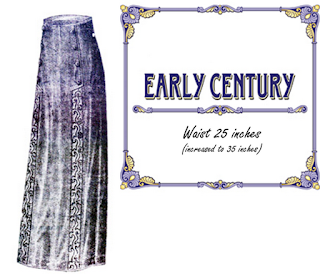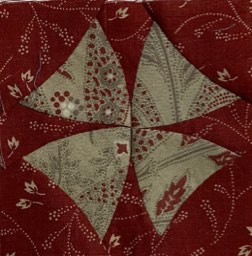This pattern calls for some strange ways of stitching together the different pieces.
If you don't want to make these seams, just work it as a mittered corner instead. Fairly easy to do it that way even though this way isn't that much more difficult. You might get a glimpse of what I mean in the picture below.
To insert lace isn't that diificult either. Where the difficulty lies, is when you are cutting (clipping) away the fabric behind the lace so you don't cut into the lace itself. When that is done you can choose between a machine seam or a hand sewn seam. When you use the machine, the stitches are tighter together and makes the whole thing a bit stiffer compared to hand sewing. Make a choice.
As usual I used what fabric I had at hand. Of course it wasn't enough for the whole flounce but needed to stitch together several pieces to make it long enough.
Then I added the insert lace and it was not the same as the one I used on the slip. Who's gonna tell?
If you study this picture carefully you will see that I din't use the same fabric for every piece. But it doesn't look bad because I mixed them up in a balanced way.
Here's the slip over the chemisse, half way there.
I used a shiny dotted tie around the neck of the slip. I stitched it down on the back and was thinking of a permanent bow in the front. I might change my mind later.
As part
of the project I will conclude with the VPLL Checklist
- Pattern
Name
Princess Slip E0336
- Sewer’s
Skill Level I think this is experiensed pattern in
difficulty due to the princess seams.
- Pattern
Rating (1-5) I loved it. 5
- Skill
Level An experiensed skill level is needed with regard
to pattern adjustments for fit and the lace insertion techniques. A guided beginner will manage this with a slower progress.
- Were
the instructions easy to follow? Generally speaking the
instructions were easy to follow. I think less experienced sewers would
benefit from more explanation on the lace insertion placement.
- How
was the fit/sizing? Pattern size was as described. As noted by
other testers the center front pattern piece is a bit wide (2 inches in my
case) through the bust area. See posts for more detail.
- Did
you make any pattern alterations? I made a few alterations regarding the lace insert at the arm opening. Left those out. Made the armpit bigger and used a narrower lace. I also
altered the pattern regarding size. I'm a bust 42 inch and had to add on the front and back side pieces. Left the front and back middle parts as they were. Added insert lace to the two back seams as well.
- Other
notes: The artist drawing of the garment as a longer
leaner line than the results using the pattern. Construction is time
intensive; this is definitely not a quick sew garment.
This pattern it the Princess Slip vpll pattern #E0336 from March 24. 1912 edition of La Mode Illustree.
My skill level:
I consider myself an Intermediate to Advanced home sewer. Self taught.
Sewing Level Required/appropriate for This Pattern:
This is a pattern suitable for an experienced sewer or an aided beginner. Maybe during class. The techniques are not very difficult when the directions are clear and with figures/pictures added. This goes for the closure at the back as well.
Pattern Rating:
I rate this as a 5 and might use it again later on as a dress pattern.
Description of Pattern:
The slip is very feminine floor length garment with princess seams that are very flattering for the body. It has insert lace down the the centre, over the princess seams in the front, across the bustline and upper bodice. It has eyelet trim gathered with ribbon around the armwholes and neckline. The neckline is finished with lace trim. It would originally have been made in white batiste with white insertion lace.
Description of Fit/Pattern Sizing
The pattern is for a 36 inch bust and I am a 42, so I needed to add a few extra inches.The pdf pattern prints in the correct size if you choose the right one. There are several to chose between depending if you are in America or in Europe. I'm 5 foot 9 and didn't have to alter the waist in any way. The gathered eyelet was necessary to keep it from gaping at the neckline. Since I didn't use the eyelet trim around the armwholes, they were as big as I wanted them to be.
Description of Alterations made to the pattern for fit:
I added 1 1/2 inch to each of the sidepanel front and back. Added 3 inch to the length by using a very narrow hem seam and a wider lace than asked for.
Description of changes I'd like in the pattern:
This one may be used for a lovely dress as well and for the modern sewer it might be nice to have a back or side zipper.
Instructions/Changes to the instructions:
The layout and printing guide was clear, and the instructions were easy to follow. To make this useful to as many sewers as possible, there ought to be more diagrams and figures added to the text. Make the flounce first and hem stitch it.
Finish the front and back before the two parts are being stitched together and the flounce added.
Then I added bias strips to the neck and armholes for strenght. I added the ribbon in the eyelet for last.
Finished garment, fabric, trim:
I used what I had in my stash: white cotto fabric, white/ivory cotton lace, cotton eyelet trim, silk dotted ribbon.
I had some old looking buttons that were perfect in size and added those.
Description of techniques:
I love the insertion lace and plan to use this technique again as I have before. Perhaps on a blouse. It is very straight forward and not difficult. It needs you to be careful and not doing this in a haste.
Using eyelet lace with ribbon to gather the neckline and armholes was a very effective technique for ensuring a good fit.
Would you Recommend this to Others?:
I would recommend this to any practical sewer who is looking for a pattern to make a pretty dress or nightgown they could wear.
Did It Look Like the Illustration When Completed?
I am 5 foot 9 tall, but even I didn't get as slim as the drawing. But that is only to be expected as every pattern has very slim line drawings to illustrate the pattern. But the finished slip looks as good as expected so that aspect of the illustration was accurate.
Other Notes:
Being part of the group has been a great motivator to get me back into sewing garments again. It is very inspiring to see what others do with the pattern. There are so many wonderful variations on this patern it's worth taking a look through them all!
























































.JPG)














